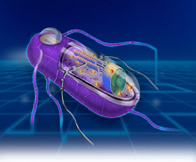Synthetic Biology
 The Synthetic Biology 2.0 conference just ended, and Rob Carlson (of open biology fame) and Oliver Morton (author of the terrific and under-appreciated Mapping Mars) attended and blogged the event. Carlson is working on his book on open biology (Learning to Fly: The past, present, and future of Biological Technology), and used his comments about the event to offer up a sample of his book-in-progress. Morton's notes are more extensive (unsurprising, given his day job as a writer/blogger for Nature), and look in some detail at the question of just how the synthetic biology tools would be used.
The Synthetic Biology 2.0 conference just ended, and Rob Carlson (of open biology fame) and Oliver Morton (author of the terrific and under-appreciated Mapping Mars) attended and blogged the event. Carlson is working on his book on open biology (Learning to Fly: The past, present, and future of Biological Technology), and used his comments about the event to offer up a sample of his book-in-progress. Morton's notes are more extensive (unsurprising, given his day job as a writer/blogger for Nature), and look in some detail at the question of just how the synthetic biology tools would be used.
So what is synthetic biology? I wrote about it a few times at WorldChanging, and the following description still works:
[Synthetic biology] is the application of mathematically-driven engineering principles to the construction of novel genetic structures; in contrast, genetic engineering is often a trial-and-error process, with numerous opportunities for and examples of unanticipated results. Many of the reasonable concerns about GMO foods and animals come from this hit or miss aspect of biotech. Biological Engineers have a more systematic approach, and use an increasingly deep understanding of how DNA works to then make microorganisms perform narrowly specified tasks.
The engineering model underlying synthetic biology goes so far as to include the use of "bio-bricks" as construction elements.
Synthetic biology specialists (it seems a bit off to call them "synthetic biologists") have managed to create both re-engineered versions of existing single-cell organisms and entirely novel "vesicle bioreactors," objects which display most of the characteristics of life.
As Carlson notes in his blog, the difference between the Synthetic Biology 1 conference and the Synthetic Biology 2 conference was that the first was all about the science, and the second was increasingly about the money. Synthetic biology is getting awfully close to commercial and potentially practical applications; this means it's getting awfully close to needing some kinds of regulation and scrupulous oversight.
It could, however, eventually become the organic equivalent of Lego, a way to build bio-objects quickly and safely, for experimentation, education, and occasional practical use. The use of pre-designed modules would go a long way towards keeping the whole process relatively safe. If these bio-Lego came with some kind of Creative Commons or GPL-style license allowing for the distribution of products, you could even imagine a kind of open source synthetic bio movement.
What's particularly interesting to me about Synthetic Biology, however, is that it's a first draft of what we'll see at the advent of molecular nanotechnology: a simpler, less-capable, model, perhaps, but offering many of the same regulatory and access questions that will emerge when nanofabbers become possible. If we can work out reasonable rules, we're almost certain to apply them to similar future technologies; if we can't, that foreshadows even more difficulty for complex future technologies. How the scientific, engineering, marketing and policy-making communities work together to figure out how to manage the commercial use of synthetic bio will likely have a great deal of influence over how molecular nanotech is regulated. CRN and other interested parties, take note.





